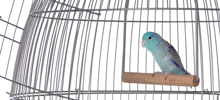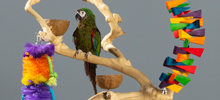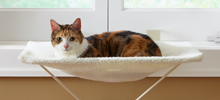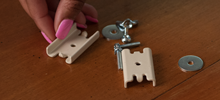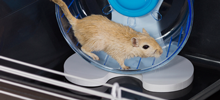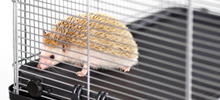FAQs
The #F040 (black) and #F041 (white) flight cages each measure 31"L x 20.5"D x 53"H and sit on a rolling caster stand. The cage includes 3 solid wood perches, 4 plastic double cups and a pull-out bottom grille and tray.
The #F050 flight cage measures 37"L x 23"W x 60"H and sits on a rolling caster stand. The cage includes 3 solid wood perches, 4 plastic double cups and a pull-out bottom grille and tray.
The #F070 and #F075 are stackable flight cage units that also function as breeder cages. The #F070 measures 37.5"L x 18"W x 40.25"H including its stand. The #F075 measures 37.5"L x 18"W x 20.5"H
Our largest flight cage is the #F030 measures 37"L x 27"D x 68"H and sits on a rolling caster stand. The cage includes 2 solid wood perches, 4 plastic double cups and a pull-out bottom grille and tray.
For smaller birds such as parakeets, we recommend the following cages:
- #31997 Bali
- #31998 Copacabana
- #31999 Round Bird Home
- #41614 Parakeet Home
- #41730 Beijing Keet Home
- #1620 Casbah Parakeet Home
- #262 Crown Roof Cage
- #270 Pagoda Roof Cage
- #25211 Keet / Tiel Offset Roof Cage
- #150 Lotus Stainless Steel Bird Home
- #151 Empress Stainless Steel Bird Home
For medium-sized birds such as lovebirds and cockatiels, we recommend the following cages:
- #152 Dynasty Stainless Steel Bird Home
- #290 Cape Cod House (Made in USA)
- #294 Victorian House (Made in USA)
- #220BLK Scrollwork Cage
- #220W Scrollwork Cage
- #110B The Lincoln (Made in USA)
- #124 The Madison (Made in USA)
- #125 Parrot Cage (Made in USA)
- #41618 Cockatiel Flight Cage
- #41615 Cockatiel House Cage
- #1804TR Triple Roof Cage
- #3351 Park Plaza Small
- #3352 Park Plaza Medium
- Integrated seed guard helps contain seeds and debris
- Elevated cage mesh eliminates the most common debris catch points seen in older cage models
- Snug-fit, removable drawer has flared edges for a tight fit that eliminates the traditional gap between the base and drawer
- Front access, removable bottom grille allows for easy cleaning without cage disassembly
- Lower-positioned cups help keep seeds from falling outside the cage as birds forage for their meals
Matching cage stands and cage stackers are also available.
The #3155S Silverado Macaw Dometop Bird Home measures 46"L x 36"D x 78 1/4"H and has 1 3/8" bar spacing.
The #3157 Empire Bird Home measures 46"L x 36"D x 78 1/4"H and has 1 3/8" bar spacing.
Both of these bird homes are constructed from 9 gauge wire and utilizes a flathead hex bolt assembly that birds cannot unscrew. They includes 3 large stainless steel, non-tip feeding bowls, a 1 1/8" diameter hardwood perch, large heavy-duty pull-out tray and pull-out bottom grille. A grille clip keeps more aggressive birds from pushing out the grille and the wind-bell clip at the top of the large front door provides additional security. There is also a feature located underneath the door lock where an additional padlock can be added (padlock not included).
We also have a "Naturals" line that contain no dyes or additives.
Some of the largest include:
- #62804 Gorilla 12"W x 27"H
- #62607 Dagwood 6" diam. x 26"H
- #62665 Caterpillar 6"W x 26"H
- #60947 Building Maze 12"L x 6.5"W x 27"H
- #62472 Fluff n Stuff 13" W x 29" H
- #62474 Bamboo Shoots 18" W x 34" H
- #60944 Waterfall 14"L x 8"W x 29"H
- #60943 Blockhead 11"L x 4"W x 32"H
- #60946 Tentacles 7"L x 5.5"W x 36"H
- Beach Walks & Beach Branches are perches made from 100% ground seashells
- Wacky Wood perches are ultra-hardwood perches made from Lima roots
- Snuggle Sacks provide birds with a soft, warm place to hide, sleep and play
- Cal-Sea-Yums toys have 100% natural ground seashell wafers
- Cosmic Crunch toys have glow-in-the-dark beads
- Chime Time toys have ground calcium wafers and aluminum chimes
- Calypso Creations toys feature crinkly paper and plastic straws
- Tropical Teasers toys are made with 100% natural, sterilized coconut fiber
Images and additional information on all of Prevue Pet's bird toys and accessories can be found on our website.
Toys are used to keep birds engaged and fit, alleviate self-destructive behavior (such as plucking), help with nest-building activities, and encourage mental stimulation. We recommend periodically changing your bird's toys to keep him (or her) happy and healthy.
Please remember, toys should be inspected daily for wear and tear and replaced as needed.
Our largest cat home is the #7500 Premium Cat Home which measures 43.25"L x 25.25"W x 65.75"H.
The smaller size is the #7501 Deluxe Cat Home which measures 43.25"L x 25.25"H x 44.875"H
Features of both cages include:
- Easy to assemble, heavy duty and rust-resistant
- No gaps or pinch points - safe for curious cats and kittens
- Wide, easy-to-open doors for full access to the entire cage
- Sturdy platforms with washable pads and fabric hammocks for sleep and playtime activity
- Ample room in the base for litter box, food and accessories
Our chain comes in both medium- as well as heavy-duty grades. The welded oval links are zinc-plated and have premium quality die-cast iron swivel bolt snap ends.
Our cable also comes in medium- as well as heavy-duty grades. We use aircraft-grade wound-steel cable which is covered by a crack-resistant, high visibility red vinyl casing. Cables have premium quality die-cast iron swivel bolt snap ends.
- Creates a designated place for your dog to tinkle when going outdoors is not an option
- Protects floors and carpets
- Makes and ideal training tool for puppies
- Easily transportable for use when traveling
- Replacement grass sold separately
Tinkle Turf comes in 3 sizes:
These are used as generalized sizes for all different types of pets, making it easy to refine what would be best suited for your pet. If you are not sure how you might categories your pet, you can choose a range, or several different sizes, to try to refine your search.
We do have an online store for Retail Stores. The first step is to sign up for a user name and password by clicking on "Dealer Login". Our sales team with then work with you to establish an account and assist you with product selection.
For birds:
- 3/8" wire spacing is for extra small birds, including finches
- 1/2" wire spacing is for small birds including parakeets
- 5/8" wire spacing is for small-medium birds including lovebirds & parrotlets
- 3/4" wire spacing is for medium birds including cockatiels or conures
- 1" wire spacing is for Large birds including African Grays & Amazons
- 1+" wire spacing is for X-Large birds such as Cockatoos and Macaws
If you have further trouble identifying your cage, please take a picture of it and email your question to: customerservice@prevuepet.com
If you still cannot find the assembly instructions or need additional help, please contact us via email customerservice@prevuepet.com or via telephone at 1-312-243-3634. To help you, we will need to know the model number of your cage.
- Model number
- UPC code
- Dimensions
- Color
SELECTING A CAGE:
A number of considerations are involved in the purchase of the "right" cage.
Proper Design For Intended Species
- Vertical Bars - for Finches, Canaries, and All Climbers
- Horizontal Bars - for Parakeets, Parrots, Cockatiels, and All Climbing Species.
Wire Spacing
- 3/8" suitable for finches and extremely small birds
- 1/2" general purpose for parakeets, canaries and all medium-sized birds
- 5/8" suitable for cockatiels, doves
- 1" suitable for all medium-to-large birds such as African grays
- 1"+ suitable for macaws, cockatoos and other large birds
Inside Cage Dimensions
- Should allow birds to comfortably spread wings
- Should have ample cage base depth for birds who do not sleep on perches
- Should have added cage height for climbing birds
- Should provide ample room capacity for toys and related treats
Special Features
- Seed guards
- Soft wood perches with proper accessibility to feeder cups
- Multiple feeder cups with ample holding capacity
- Sufficiently large doors for easy access and to accommodate bird's size
- A practical method of locking and securing doors
Swing Style
- Proper dowel diameter for species
- Proper hanging depth from top
- An appropriate size that will not over-crowd cage
- Possibility to be sturdily secured to top cage bars
Cage Construction
- In most cases, cost does dictate the amount of quality put into cage construction
- All plastic parts should have thick walls, especially in corner areas
- Metal parts should not have any sharp edges. They should encompass solid multi-welds and should have an adequate application of plating or paint coverage
- Generally speaking, all-steel constructed cages are preferable due to their longevity value and their ability to withstand more shock and cleaning than their plastic counterparts.
Cage Finish
- Clear lacquer applied to all plated parts
- Use of non-toxic, baked paints only
Cage Care
- Plated and Powder-Coated Finishes - Clean with a soft damp cloth and immediately dry with a soft, dry cloth. Never use abrasive soaps or abrasive cleaning pads. Avoid use of extremely hot water in cleaning. Plated items (brass or nickel) have a protective clear lacquer coating applied during the plating process. If this clear coating is worn off by excessive abrasive cleaning - or by years of use - the base plating will begin to oxidize. If oxidation does begin, it is recommended that consideration be given to replacing the entire cage or - at a minimum - the part that is oxidizing.
- Painted finishes - should always be baked on during the painting process. To avoid future rusting, immediately use touch-up paint on any chipped or scratched areas. All epoxy liquid paint, epoxy powder coatings, and all plating finishes used on Prevue cages are laboratory-tested to be "Child Safe and Pet Safe"... of paramount importance. Lead-based coating materials are never used.
CARING FOR YOUR BIRD
- Cage Placement - Be sure your bird has plenty of shade and is far enough away from any possible hazardous fumes. Always keep bird out of reach of other pets as well as small children
- Add Toys - Keep your bird entertained and it will entertain you. After 2 weeks in the new cage, gradually add play-things. Prevent overcrowding by keeping to a minimum the number of toys in the cage at one time. Rotate the toys for variety.
- Bathing - Birds enjoy bathing, do it often. It's also necessary to keep their feathers in good shape. Use a cage-mounted bird bath. It is also a good idea to "mist" your bird frequently using a hand-held, spray-pump applicator.
- Provide Cuttlebones - By chewing and rubbing this helps keep the beak from overgrowing and provides essential calcium. Always keep a cuttlebone in the cage.
- Cleaning Cage - Keeping the cage clean helps prevent disease as well as freeing your bird from dirt and oil. Wash water and food cups daily, using a mild dish-washing detergent applied with a soft cloth or soft bristle brush.
- Help During Molting - Spring is generally molting season. As the bird loses its insulating feathers, keep the cage warm. Cover the cage for longer periods so your bird can sleep more during this stressful time.
PROPER FOOD
- Select Quality Food - High quality food helps keep your bird healthy and energetic. Use the proper mix of pellet, seed mix, and fresh fruits and vegetables every day. Select seed mix with supplemental vitamins. Pellets provide the proper vitamins to assure a natural balance. Consult your veterinarian for further dietary information and recommendations.
- Add Grit to Food - Limited to pigeons and doves only. Grit helps grind up foot so it doesn't get lodged in the bird's gizzard. All other pet bird species utilize digestive minerals as supplementation. These are easily obtained through the addition of cuttlebone, mineral blocks, or prepared egg shell compound to the cage environment. Consult your veterinarian.
- Ration the Portions - Provide only what your bird will eat in one sitting.
- Treat Your Bird - Provide treats once or twice a week to add variety and stimulate appetite.
- Food Supplement - Add fruit or vegetables to your bird's diet daily. Reference books will advise of the proper fruits and vegetables for the breed, or consult your veterinarian.
- Add Water - Provide clean, fresh drinking water every day, in addition to the bath water. Do not take your water source for granted. The supply should be monitored on a regular basis for heavy metal contaminants which can affect your pet's health.
Our Zzz's line includes 3 different items made from a super-soft, suede-like material that invites ferrets to curl up & drift off to sleep. Model numbers are:
Toys include:

